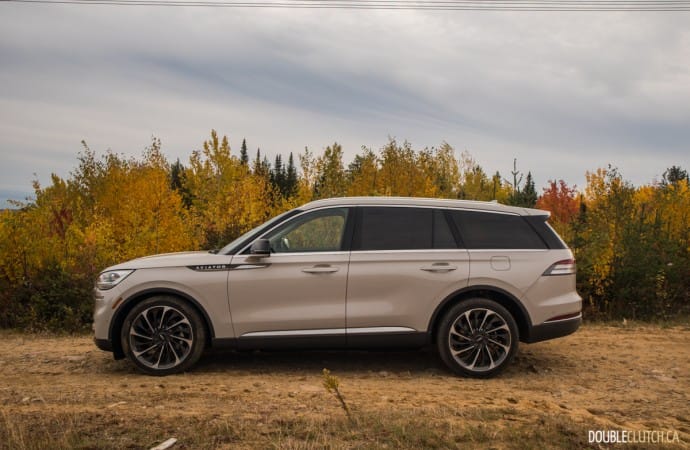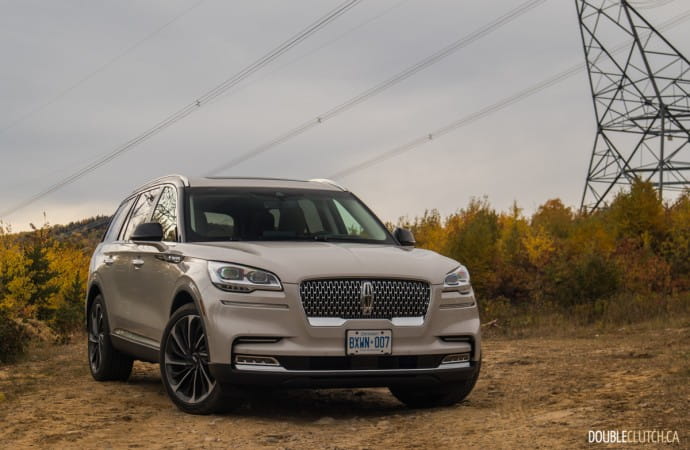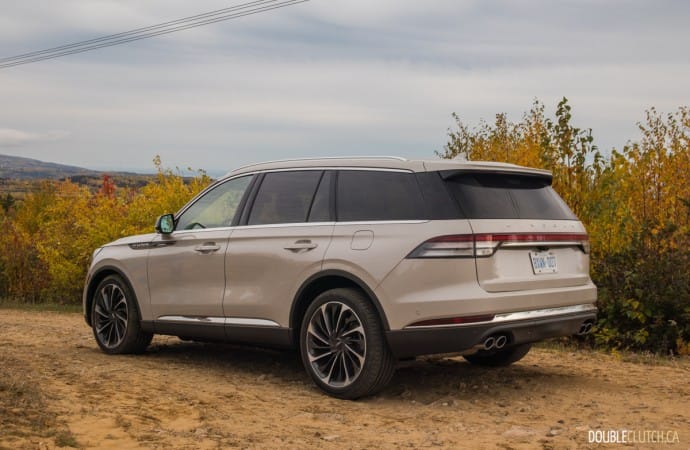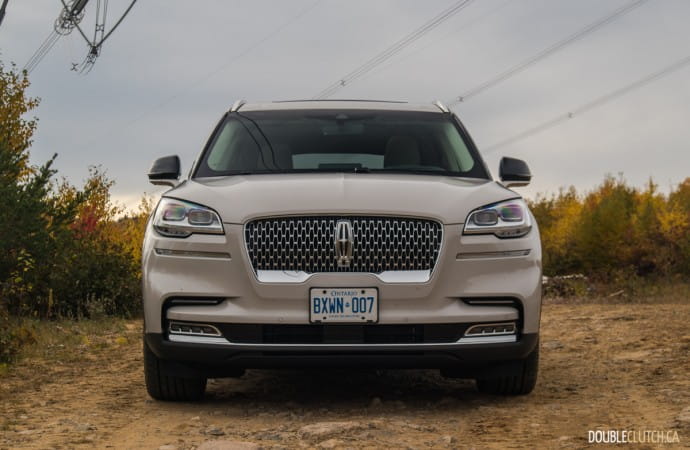QUÉBEC CITY, QUÉBEC – All new for the 2020 model year, Lincoln has been speaking of their new Aviator crossover for quite some time now. I was at the New York International Auto Show in 2018 when we first saw the production model, and subjectively, it’s one of the best looking crossovers on the road. The Aviator also adds plug-in hybrid electrification to the Lincoln brand for the first time ever, making it a true step forward for the brand. We were invited to spend a couple of days in the Charlevoix region of Québec, to sample the 2020 Lincoln Aviator in multiple configurations.

From a design perspective, the Aviator builds on the language that the Lincoln brand has introduced over the last few years. It may have the best proportions yet, and almost mimics Range Rover’s lines in certain ways. The new Adaptive Pixel LED headlights on higher trim levels look sharp during the day and even classier at night, and the rear light bar is stunning when lit. Worth noting, the Aviator shares its basic architecture with the 2020 Ford Explorer.
Interior materials in the Aviator are surprisingly good, and it’s a nicer place to be than the flagship Navigator (reviewed here). While the Navigator’s Ford-roots are fairly obvious, and certain Lincoln touches are skin-deep, the Aviator has its own unique identity. Fit and finish is also excellent, and there’s minimal use of plastics throughout the cabin. The 30-way Perfect Position seats are comfortable and make no secret of their ability to cocoon all passengers over longer hauls. Visibility is more than adequate, as is space for rear seat occupants.

The Aviator’s cabin is filled with technology, and it only starts with the large touchscreen powered by SYNC 3, capable of syncing with many mobile apps such as Waze. It’s also supportive of Apple CarPlay and Android Auto, a standard in today’s industry. A new heads-up display is crystal clear, and has been optimized to work even when wearing polarized glasses. Lincoln’s Co-Pilot360 Plus tech is also on board, starting with adaptive cruise control and including features like Evasive Steering Assist, Reverse Brake Assist, blind spot information, and much more. An optional Revel Ultima 3D audio system with 28 speakers is one of the better examples in the business.
The standard engine for the Aviator is a 3.0-liter V6, twin-turbocharged, and offering 400 horsepower and 415 lb-ft. of torque. It’s paired with Ford Motor Company’s 10-speed automatic transmission, and also has paddle shifters for those who want to shift their own gears. This powertrain will be more than enough for most buyers, and actually makes for decent all-around performance. The Aviator never feels restrained, and accelerates confidently to highway speeds with the serenity that’s expected from a luxury crossover at this price point.

Turbo lag is minimal, and the 10-speed automatic does a good job of changing gears imperceptibly and smoothly. Those wanting more power will want to opt for the Aviator Grand Touring plug-in hybrid variant, which adds a 13.6-kWh battery pack and an electric motor between the engine and transmission. Numbers go up to 494 horsepower and 630 lb-ft. of torque, and an electric-only electric driving range. This model goes on sale later this year, and thus we were not able to sample it just yet.
The Aviator’s standard all-wheel-drive system is rear-biased, which adds to its premium appeal. Other vehicles in its segment such as the Acura MDX SH-AWD (reviewed here) and Infiniti QX60 often use front-based all-wheel-drive systems, but this isn’t the case. Ride quality is superb especially with the Air Glide Suspension, with an adaptive damping setup that absorbs bumps remarkably well. Another point in the Aviator’s favour is the unibody architecture rather than the Navigator’s jittery body-on-frame layout that still doesn’t ride as well as its GM rivals. Models without the air suspension still receive adaptive dampers, though they’re paired to a regular coil setup.

Fuel consumption for the standard V6 model is rated at 13.8L/100km city and 9.7L/100km highway, for a combined 11.9L/100km rating. Through our trek across Québec without any focus on fuel efficiency, we observed 12.3L/100km operating on premium 91-octane fuel, recommended for optimal performance. Adding to efficiency is a start-stop system as well as optimized aerodynamics thanks to the air suspension that lowers at high speeds.
Pricing for the Aviator Reserve starts at $69,000, and a $9,000 option package adds a Class IV towing package, 22-inch wheels, and an Illumination Package. A $3,500 Dynamic Handling Package adds adaptive steering, four-corner air suspension and Adaptive Suspension with Road Preview. The Grand Touring model with the plug-in hybrid powertrain starts at $81,000 and comes fairly loaded. In gasoline form, the Aviator can tow 6,700 pounds, while the PHEV model will be able to haul 5,600 pounds. Both of these numbers require the vehicle to be equipped with the towing package.

Context is an interesting thing. The Aviator’s $69,000 starting price puts it significantly higher than the Acura MDX, and even $3,000 higher than the base price of the 2020 Mercedes-Benz GLE 450 (reviewed here). The Volvo XC90 is the most obvious competitor and also one of our perennial favourites; pricing is in line with higher-spec models of the Volvo. The Aviator rides significantly better than the Volvo, and the engine is more refined in both feel and performance – the Aviator’s base engine is more powerful than the Volvo’s top-trim T8 variant (reviewed here). The Range Rover Sport also gets honorary mention in this ball game.
Lincoln is still trying to re-establish their brand image as a luxury brand, along with Cadillac. While all materials are very nice, the price point puts the Aviator up there with some pretty heavy hitters from Germany and the United Kingdom. The Range Rover Sport (reviewed here) with its standard air suspension setup still has superior ride quality, but the Lincoln’s powertrain is impressive. The Cadillac XT6 has just entered the market and is similar in size, but its level of luxury is very obviously a notch below that of the Aviator.

The 2020 Lincoln Aviator is the start of something new for Lincoln, and a continuation of the return of actual names rather than alphabet soup. The last Aviator was a loosely rebranded Ford Explorer/Mercury Mountaineer, and while this new version shares some components with the 2020 Explorer (reviewed here), it’s a luxury vehicle in its own right. With significantly higher quality levels than the Continental sedan, and a smoother ride than the full-frame Navigator SUV, the Aviator has quickly become the favourite child of the Lincoln family.
See Also:
2019 Lincoln Navigator Reserve L
2019 Lincoln MKC Reserve 2.3T
First Drive: 2020 Ford Explorer

